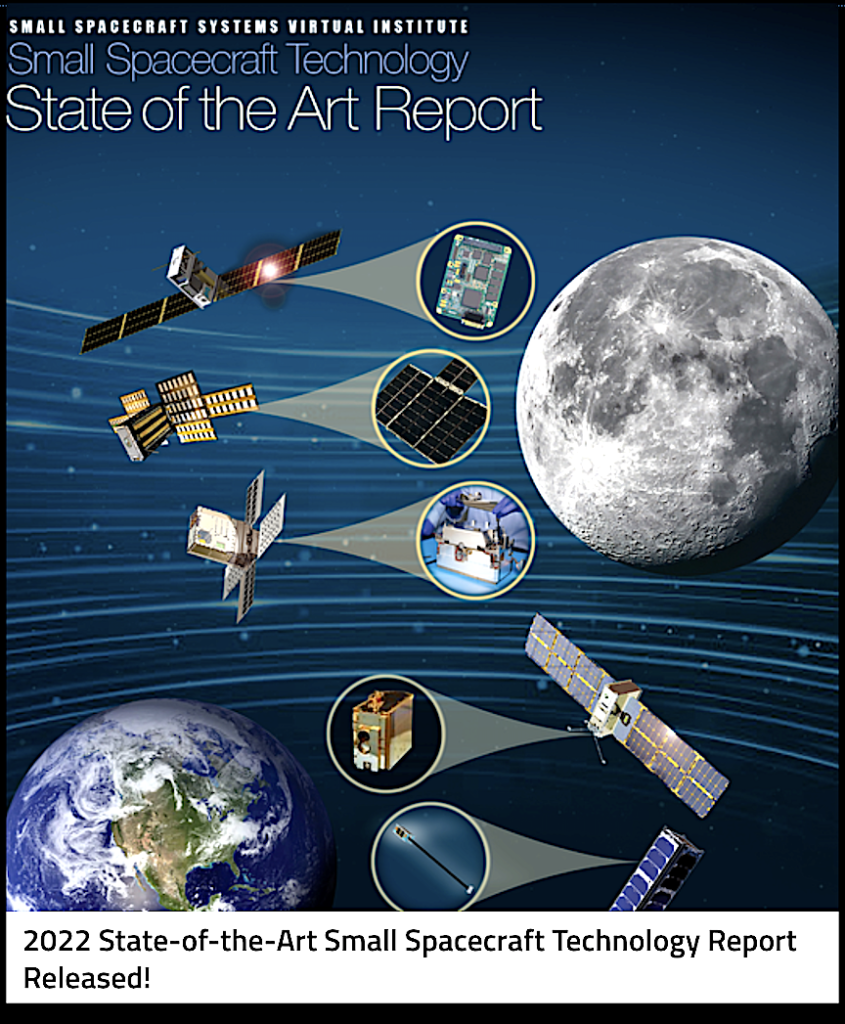
The following is an announcement from NASA…
NASA’s Small Spacecraft Systems Virtual Institute is pleased to announce the official release of the 2022 State-of-the-Art Small Spacecraft Technology report. This endeavor was made successful by the contributions of numerous people across NASA and other organizations who served as authors and reviewers. We thank them and the individuals from the companies, universities, and organizations that provided their time and information for this report.
When the first edition of NASA’s Small Spacecraft Technology State-of-the-art report was published in 2013, 247 CubeSats and 105 other non-CubeSat small spacecraft under 50 kilograms (kg) had been launched worldwide, representing less than 2% of launched mass into orbit over multiple years. In 2013 alone, around 60% of the total spacecraft launched had a mass under 600 kg, and of those under 600 kg, 83% were under 200 kg and 37% were nanosatellites (1). Of the total 1,849 spacecraft launched in 2021, 94% were small spacecraft with an overall mass under 600 kg, and of those under 600 kg, 40% were under 200 kg, and 11% were nanosatellites (1). Since 2013, the fight heritage for small spacecraft has increased by over 30% and has become the primary source to space access for commercial, government, private, and academic institutions. The total number of spacecraft launched in the past 10 years is 5,681 and 45% of those had a mass <200 kg (1).
As with all previous editions of this report, the 2022 edition captures and distills a wealth of new information available on small spacecraft systems from NASA and other publicly available sources. This report is limited to publicly available information and cannot reflect major advances in development that are not publicly disclosed. We encourage any opportunity to publish mission outcomes and technology development milestones (e.g., via conference papers, press releases, company website) so they can be reflected in this report.
Overall, this report is a survey of small spacecraft technologies sourced from open literature; it does not endeavor to be an original source, and only considers literature in the public domain to identify and classify devices. Commonly used sources for data include manufacturer datasheets, press releases, conference papers, journal papers, public filings with government agencies, news articles, presentations, the compendium of databases accessed via NASA’s Small Spacecraft Systems Virtual Institute (S3VI) Information Search, and engagement with companies. Data not appropriate for public dissemination, such as proprietary, export controlled, or otherwise restricted data, are not considered.
As a result, this report includes many dedicated hours of desk research performed by subject matter experts reviewing resources noted above. Content in this 2022 edition is based on data available by October 2022. This report should not be considered as a comprehensive overview of all the technologies but a great reference for the current state-of-the-art SmallSat technologies
The report contains an overview of current state-of-the-art SmallSat technologies and their development status as discussed in open literature. It is not intended to be an exhaustive representation of all that is available on a particular topic. Commonly used sources for public data include manufacturer datasheets, press releases, conference papers, journal papers, public filings with government agencies, and news articles. Readers are highly encouraged to reach out to companies for further information regarding the performance and maturity of the described technology.
The report is available online in webpage format as well as in PDF format as a whole document or in single chapters.
Visit: https://www.nasa.gov/smallsat-institute/sst-soa Suggestions or corrections to this document should be submitted to the NASA Small Spacecraft Systems Virtual Institute at Agency-SmallSat-Institute@mail.nasa.gov for consideration prior to the publication of future issues.
- Bryce and Space Technology. “SmallSat by the Numbers, 2022.” [Online] Accessed: September 28, 2022. https://brycetech.com/reports/report-documents/Bryce_Smallsats_2022.pdf
